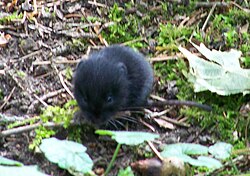Common kestrel
The common kestrel (Falco tinnunculus) is a bird of prey species belonging to the kestrel group of the falcon family Falconidae. It is also known as the 'European kestrel', 'Eurasian kestrel', or 'Old World kestrel'. The bird lives all over Europe, Asia, and Africa.
| Common kestrel | |
|---|---|

| |
| Adult male Falco tinnunculus tinnunculus | |
| Conservation status | |
| Scientific classification | |
| Kingdom: | |
| Class: | |
| Subclass: | |
| Infraclass: | |
| Superorder: | |
| Order: | |
| Family: | |
| Genus: | |
| Binomial name | |
| Falco tinnunculus Linnaeus, 1758
| |

| |
| Western part of range of F. t. tinnunculus (also occurs in Siberia farther east) Yellow = breeding only, green = all-year | |
In Britain, where no other brown falcon occurs, it is generally just called 'the kestrel'.[1]
Description
Kestrels are 32–39 cm (13–15 in) from head to tail. Their wings are 65–82 cm (26–32 in) when spread out. Females are larger. They are small compared with other birds of prey, but larger than most songbirds. Like the other Falco species, they have long wings and a long tail.[2]
Their feathers are mainly light brown with black spots on the top and buff with narrow blackish streaks on the underside.[2]
Food and feeding
When hunting, kestrels hover about 10–20 m (c.30–70 ft) above the ground. They can see the slightest movement. They can see small prey from a distance. Once they see the prey, the bird makes a short, steep dive. Kestrels eat almost any mouse-sized mammals like voles. They also eat shrews and true mice. Small birds are also eaten, mostly in the summer when young birds are born. The bird also eats spiders and beetles when it finds them.[2]
Common Kestrel Media
Falco tinnunculus - Common Kestrel
European pine vole (Microtus subterraneus), a typical common kestrel prey since prehistoric times
Female wintering in Kinnerasani Wildlife Sanctuary (Andhra Pradesh, India)
F. t. canariensis on Gran Canaria
F. t. rupicolaeformis from Hurghada, Egypt
Footnotes
- ↑ Mangoverde World Bird Guide (MWBG) [2009]: Eurasian Kestrel Falco tinnunculus. [1]
- ↑ 2.0 2.1 2.2 Orta, Jaume 1994. Common kestrel. In: del Hoyo, Josep; Elliott, Andrew & Sargatal, Jordi (editors): Handbook of Birds of the World, Volume 2 (New World vultures to Guineafowl): 259-260, plates 26. Lynx Edicions, Barcelona. ISBN 84-87334-15-6
Other websites
| Wikimedia Commons has media related to Lua error in Module:Commons_link at line 62: attempt to index field 'wikibase' (a nil value).. |
- Common kestrel from ARKive
Facts Status Description Range Habitat Biology Threats Conservation Find out more Glossary References View all











